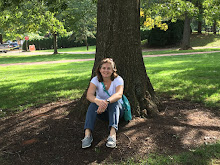Sunday, August 30, 2009
Emerging Vocabulary
Exploration and Intention
Sunflower picture: When I started this picture I was thinking about how our sunflowers in our garden were not growing. I knew what I wanted it to look like before I painted it. It was not an experiment. I had a plan in my head.
I used some of the same brushes from my first picture and I especially liked the small brush and the big, thick brush (looks like a BBQ brush that you would put sauce on the grill). I mixed fewer colors than the first time because I wanted to use less colors.
I like the way it came out because the sunflower is the main idea and pops out of the picture without you focusing on the smaller background details.
Asking the artist to comment on her process provided an opportunity for us to learn more about her intentions and ideas. Prior to reading her comments I had forgotten about the conversation about stalactites as she was exploring dripping paint in the first picture and had not know the motivation for her very purposeful sunflower picture. The story of the creative process and the stories that motivate it enrich the viewing of the picture.
Risk Taking and Happy Accidents
Friday, August 28, 2009
Eric Carle and his Caterpillar Share a Birthday
If you were an art teacher, what would your class look like?
"When I was an art student, we painted colorful paints, all kinds of colors on sheets of paper, and that way we accumulated a nice collection of color. Then we tore out shapes, cut out shapes, made collages. It's not so important that right away you go ahead and do houses and animals. The children could make birds or elephants, if they like, but I'm not saying to do anything. If you just do abstract shapes and squares and you play with them, it would be a wonderful thing.
Some schools I've been to, they collect all kinds of discarded things -- wools and papers and sticks and stones. They make collages out of that and I think that's wonderful, rather than sitting a child down and saying, "Now draw a tree!" Maybe the child is not in the mood to draw a tree!"
Wednesday, August 12, 2009
Papermaking at Caretaker Farm
Tuesday, August 4, 2009
Mosaic Making - A Community Project
Piecing in the background - our progress so far.
